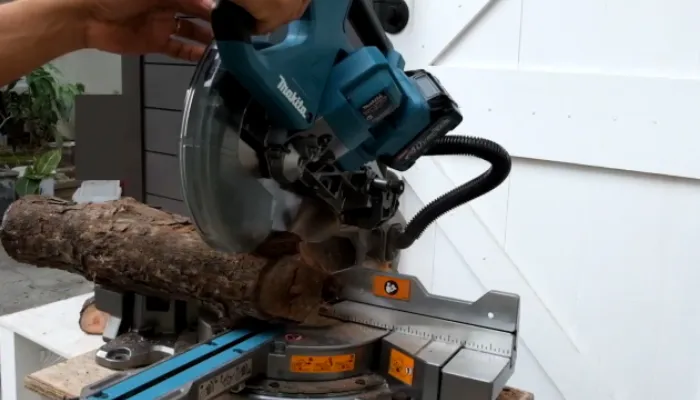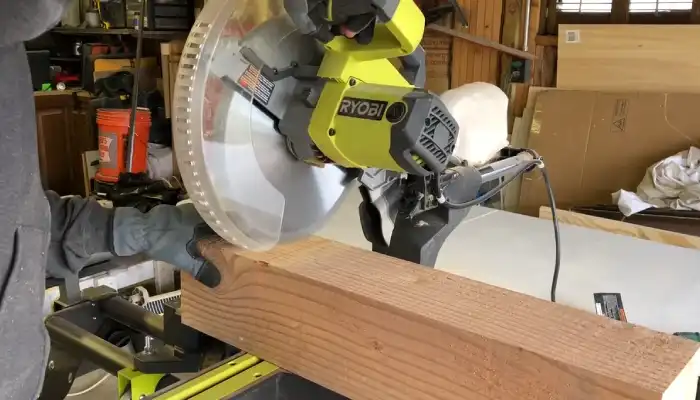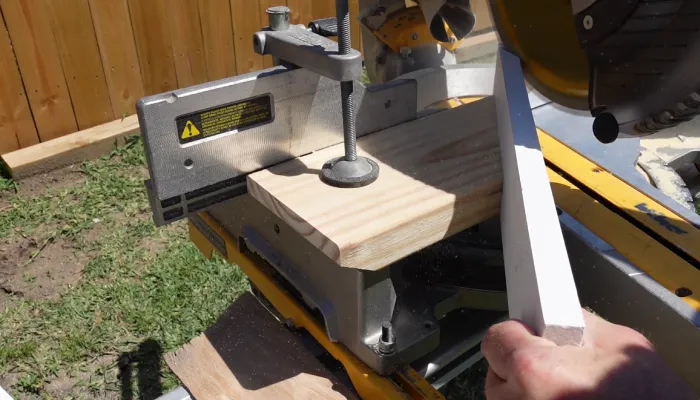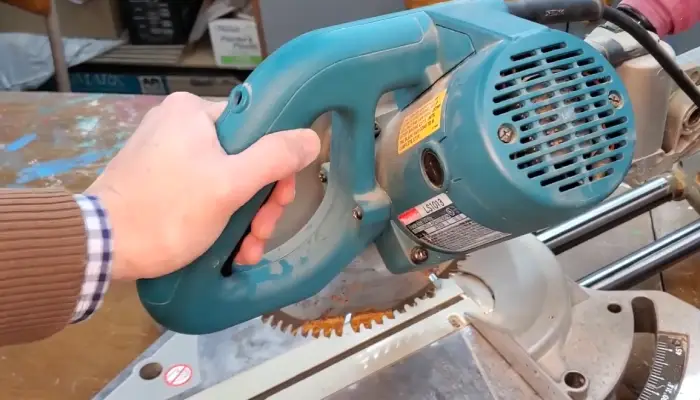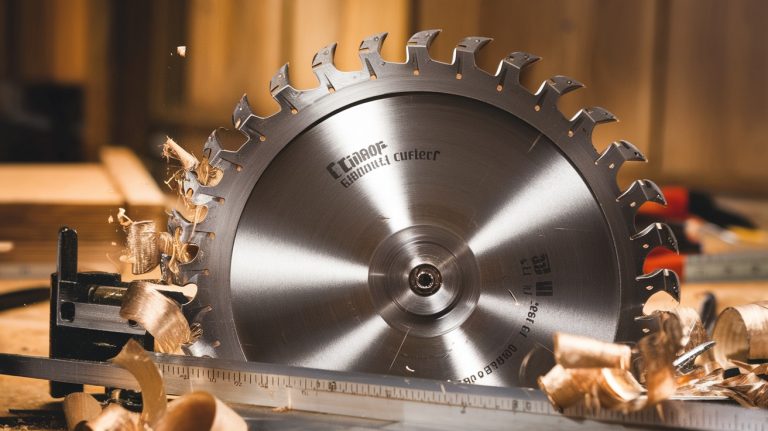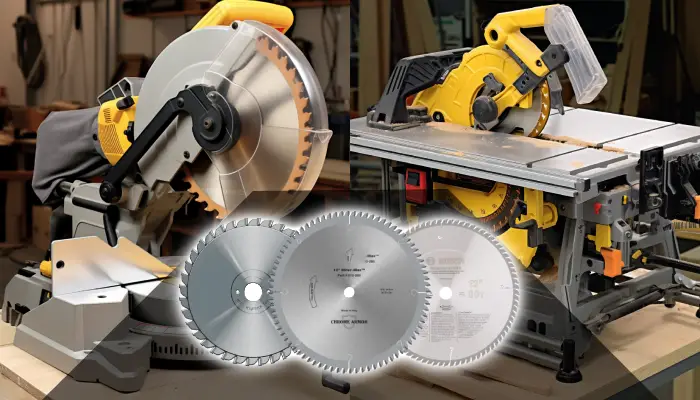Why Does My Miter Saw Kickback: 8 Causes & Solutions
Safety is paramount when operating power tools and this holds particularly true for miter saws, which are invaluable tools in woodworking projects. Among the potential hazards associated with miter saw use, kickback stands out as a significant concern.
One possible cause is blade binding, where the blade gets stuck in the wood and is suddenly released, causing a kickback. Another reason could be wood irregularities, such as knots or grain direction, leading to unpredictable movements.
Using wet or pitchy wood, dull or inappropriate blades, or improper saw maintenance can also contribute to kickback.
With this article, we’ll look into the reasons behind the annoying kickback and provide you with effective solutions. You’ll learn how to avoid kickback during wood cutting and discover its associated risks. Plus, we’ll explore whether laser guides on miter saws help prevent kickback.
What Causes Your Miter Saw Kickback During Wood Cutting?
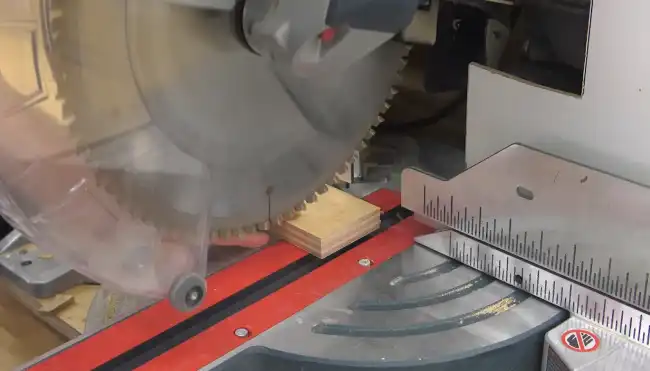
If you’re experiencing kickback with your wood cutting miter saw, there could be a few reasons behind it. Here are some of the most common causes of kickbacks:
- Blade binding
- Wood irregularities
- Wet or pitchy wood
- Dull or inappropriate blade
- Improper saw maintenance
- Forcing the blade
- Material support and fence contact
- Foreign objects
Let’s look at each of these causes in more detail and discuss how you can fix them.
No 01: Blade Binding
Kickback occurs when the saw blade binds in the material, often due to the kerf closing in on the blade. This can happen when the saw blade gets pinched by the material, causing it to stop suddenly and reverse.
To prevent blade binding and potential kickback, choosing the right blade for the job is essential. Ensure you’re using a sharp blade appropriate for the type of wood you’re cutting.
Different types of wood require different blades, so be sure to select one that matches the hardness and density of the wood you’re working with. Blades designed for sliding miter saws often have features specifically to reduce binding.
No 02: Wood Irregularities
Wood with irregularities can lead to kickback on your miter saw. When the blade encounters a knot or warped section, it can cause the wood to shift or bind, resulting in a dangerous situation.
To prevent this, take the time to carefully examine your material before cutting. Look for any knots, cracks, or areas of warping. If you spot any, approach them with caution. Make sure the blade is well clear of these areas to avoid binding.
No 03: Wet or Pitchy Wood
Using wet or pitchy wood increases your risk of kickback due to the blade binding and not cutting smoothly. When wood is wet or contains pitch, it becomes sticky and can cause the blade to get stuck during the cutting process. This can result in the wood being thrown back towards you, causing injury or damage.
To avoid kickback when working with wet or pitchy wood, it’s important to take certain precautions.
- Ensure that your miter saw blade is sharp and in good condition.
- Consider using a blade specifically designed for wet or resinous materials with special coatings and tooth designs to prevent buildup.
No 04: Dull or Inappropriate Blade
Ensure your blade is sharp and appropriate for the type of wood and cut you’re making to reduce the risk of kickback. A dull or inappropriate blade is a common reason for a kickback when using a miter saw.
A blade that isn’t sharp enough or not designed for the specific task can cause the wood to bind or catch, leading to kickback.
To prevent this, ensure your blade is in good condition and suitable for the type of wood you’re cutting. Choose a blade with the appropriate number of teeth and tooth configuration for your specific cut. Always use the right blade to ensure safety and achieve clean and precise cuts.
No 05: Improper Saw Maintenance
Neglecting proper maintenance can lead to issues with the saw’s performance and safety. Over time, dust, debris, and sawdust can accumulate in the moving parts, causing friction and hindering the smooth operation of the saw. This can result in play in the working parts, which increases the chances of kickback.
By regularly inspecting and cleaning your miter saw, you can ensure that it operates smoothly and accurately. Clean the dust and debris from the blade guard, fence, and other moving parts. Lubricate the saw’s components as the manufacturer recommends to keep everything in proper working order.
Regular maintenance won’t only prevent kickback but also extend the lifespan of your saw.
No 06: Forcing the Blade
This is a common mistake that many people make, but it can have serious consequences. When you push too hard, you’re not allowing the saw to cut at its own pace, which can cause the blade to bind or deflect. When that happens, the risk of kickback increases significantly.
The key here is to let the saw do the work. Maintain a steady and controlled feed rate and resist the urge to force the blade through the material. Doing so will minimize the risk of kickback and ensure a safer and more efficient wood cutting experience.
No 07: Material Support and Fence Contact
Inadequate support for the workpiece or improper contact with the fence can cause instability and kickback. When cutting a wood piece without adequate support, the force of the blade can cause the material to flex and move. This can lead to kickbacks and a potentially dangerous situation.
You can prevent instability and kickback by ensuring proper support for the workpiece and maintaining contact with the fence. Adequate support on both sides of the blade helps keep the material in place during the cut, reducing the risk of shifting.
When the workpiece is properly supported and in constant contact with the fence, you create a stable and secure cutting environment. This ensures that the material remains in its intended position throughout the cutting process, minimizing the chances of kickback.
No 08: Foreign Objects
Staples, screws, or nails hidden in the wood can be dangerous when encountered by the blade, causing it to kick back. Plus, these objects can cause damage to the saw blade and the workpiece.
Use a metal detector or visually inspect the material to identify and remove potential hazards. Take the time to thoroughly check for any foreign objects, even if the wood appears clean at first glance.
By being diligent in this process, you can significantly reduce kickback risks and ensure a safe-cutting experience.
How Can Kickback Be Avoided at the Miter Saw During Wood Cutting?
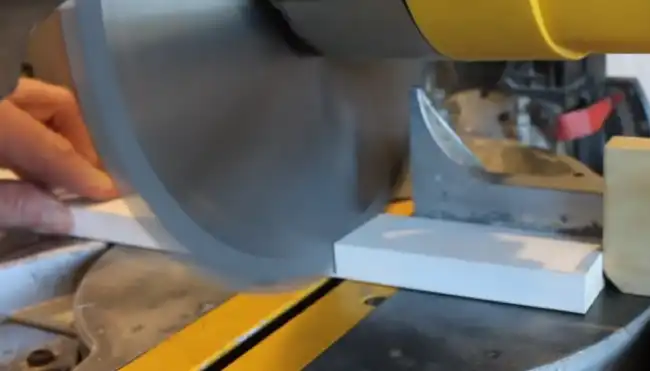
To avoid kickback at the miter saw during wood cutting, you can take some key precautions.
Tips #1: Blade and Material Compatibility
Make sure the blade you’re using suits the type of wood you’re cutting with your miter saw. Using the wrong blade can lead to kickback and other safety issues.
Different blades are designed for different wood types and cutting techniques, so choosing the right one is crucial. A blade with the wrong tooth configuration or thickness can cause the wood to bind or splinter, increasing the risk of kickback.
To ensure compatibility, check the manufacturer’s recommendations for your miter saw and the specific wood you’re working with. Always use a sharp blade that’s in good condition, as dull blades can increase the chances of kickback.
Tips #2: Safety Features and Instructions
Always refer to your miter saw’s safety manual for proper usage and guidelines.
Regarding safety, miter saws are equipped with various features to prevent kickback and ensure your protection. One of the most important safety features is the blade guard. This protective cover helps to keep your hands and fingers away from the spinning blade, reducing the risk of accidents.
Additionally, miter saws often come with safety instructions that outline proper handling techniques and precautions. These instructions may include recommendations for using clamps to secure the material, maintaining a firm grip on the saw handle, and avoiding sudden movements.
Tips #3: Zero Clearance Inserts
Using zero clearance inserts in your miter saw can prevent small off-cuts from getting wedged and launched during the cut. These inserts are designed to fit tightly around the blade, creating a narrow channel that supports the workpiece and minimizes the risk of kickback.
When the off-cut pieces have nowhere to go, they’re less likely to cause accidents or damage to the workpiece. By filling in the gap between the blade and the throat plate, zero clearance inserts provide a stable surface for the wood to rest on, ensuring clean and accurate cuts.
These inserts can be easily customized to match the thickness of the blade, maximizing safety and precision. Incorporating zero clearance inserts into your miter saw setup is a simple yet effective way to improve your cutting experience and reduce the chance of kickback incidents.
Tips #4: Proper Material Support
Use a stable fence on both sides of the blade to ensure a stable workpiece during cuts. Proper material support is crucial for preventing kickback and ensuring accurate cuts on a miter saw.
Make sure to use a sturdy fence securely attached to the saw’s table on both sides of the blade. The fence should be set at the correct height and angle to provide optimal support for the material.
Tips #5: Secure Workpiece
Ensure you clamp or secure your workpiece to prevent movement and vibration while cutting. This is crucial to ensuring a safe and accurate wood cutting experience with your miter saw.
Use clamps or other secure methods to hold the workpiece in position. Additionally, ensure the material is properly supported to prevent sagging or bending, which can also contribute to kickback.
Tips #6: Correct Alignment
Aligning the material accurately with the fence and bed of the saw is crucial for maintaining stability during your cuts.
To achieve correct alignment, ensure that your material is snug against the fence and flush with the bed of the saw. Use clamps or other securing methods to keep the material in place. Double-check your alignment before making any cuts, as this simple step can greatly reduce the risk of kickback.
Tips #7: Controlled Feed Rate
Maintain a steady and controlled feed rate to avoid potential accidents and ensure a smooth cutting experience. When operating a miter saw, feeding the wood into the blade at a consistent pace is crucial. Sudden movements can lead to binding or kickback, which can be dangerous and cause damage to the material being cut.
By controlling the feed rate, you can prevent the saw from getting overwhelmed and maintain control over the cutting process. This means keeping a firm grip on the workpiece and gradually pushing it towards the blade. Avoid forcing the wood or applying excessive pressure, as this can also contribute to kickback.
Tips #8: Safe Operator Positioning
To ensure your safety while operating the miter saw, stand to the side of the blade and keep your hands away from it at all times. This is crucial because kickback can occur when the wood being cut is propelled back towards the operator.
Using push sticks or blocks can help maintain control over the wood and prevent kickback. These tools allow you to guide the wood through the cut without placing your hands too close to the blade.
Tips #9: Post-cut Safety
After completing a cut on your wood cutting miter saw, it’s crucial to prioritize post-cut safety. Before anything else, ensure the blade has completely stopped spinning to avoid accidental injuries.
Once you’ve confirmed the blade’s halt, take a moment to carefully remove the cut piece from your workspace. Leaving it there can lead to potential hazards, such as tripping or damaging the piece. By promptly clearing the workspace, you maintain a clutter-free area, reducing the risk of accidents.
Taking these precautions tips will help maintain control over the cutting process and reduce the risk of kickback.
What is the risk of miter saw kickback?
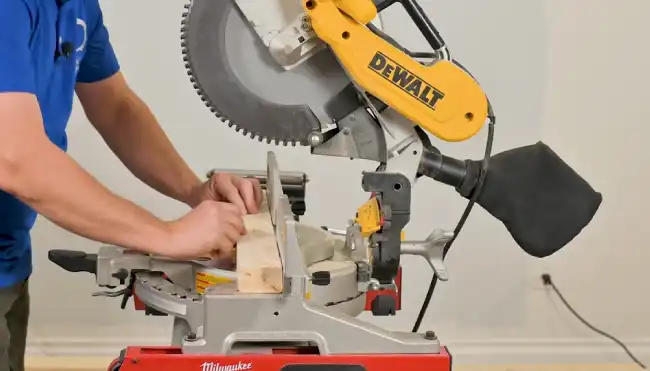
Be aware that miter saw kickback poses a significant risk of injury. When kickback occurs, the spinning saw blade catches on the cut material, causing it to be forcefully thrown back towards you.
This can result in severe injuries, such as cuts and lacerations, and in some cases, even amputation of fingers or impalement with the material being thrown back.
Can using a laser guide on my miter saw help prevent kickback?
Using a laser guide on your miter saw can enhance the precision of your cuts, but it doesn’t directly prevent kickback. The laser guide helps you achieve more accurate results. It serves as a visual aid, showing you where the cut will be made.
However, it’s important to understand that kickbacks can still occur without proper safety precautions.
Mitigating the Risk of Miter Saw Kickback
Kickback is a common issue with wood-cutting miter saws, but it can be avoided by following proper safety measures. Always ensure the blade is sharp, use a push stick for smaller pieces, and maintain a firm grip on the workpiece.
Understanding and implementing the measures to prevent kickback is fundamental to safe miter saw operation. From choosing the right blade to maintaining proper alignment and supporting workpieces adequately, these precautions form a comprehensive approach to mitigating the risk of kickback.By following these guidelines diligently, you safeguard yourself and ensure that your woodworking journey remains productive and free from unnecessary setbacks. Stay informed and stay safe while using your miter saw.

